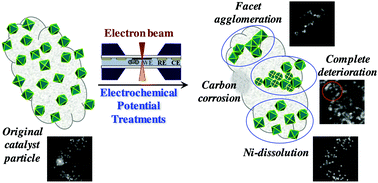Real-time imaging of activation and degradation of carbon supported octahedral Pt–Ni alloy fuel cell catalysts at the nanoscale using in situ electrochemical liquid cell STEM†
Abstract
Octahedrally shaped Pt–Ni alloy nanoparticles on carbon supports have demonstrated unprecedented electrocatalytic activity for the oxygen reduction reaction (ORR), sparking interest as catalysts for low-temperature fuel cell cathodes. However, deterioration of the octahedral shape that gives the catalyst its superior activity currently prohibits the use of shaped catalysts in fuel cell devices, while the structural dynamics of the overall catalyst degradation are largely unknown. We investigate the time-resolved degradation pathways of such a Pt–Ni alloy catalyst supported on carbon during cycling and startup/shutdown conditions using an in situ STEM electrochemical liquid cell, which allows us to track changes happening over seconds. Thereby we can precisely correlate the applied electrochemical potential with the microstructural response of the catalyst. We observe changes of the nanocatalysts’ structure, monitor particle motion and coalescence at potentials that corrode carbon, and investigate the dissolution and redeposition processes of the nanocatalyst under working conditions. Carbon support motion, particle motion, and particle coalescence were observed as the main microstructural responses to potential cycling and holds in regimes where carbon corrosion happens. Catalyst motion happened more severely during high potential holds and sudden potential changes than during cyclic potential sweeps, despite carbon corrosion happening during both, as suggested by ex situ DEMS results. During an extremely high potential excursion, the shaped nanoparticles became mobile on the carbon support and agglomerated facet-to-facet within 10 seconds. These experiments suggest that startup/shutdown potential treatments may cause catalyst coarsening on a much shorter time scale than full collapse of the carbon support. Additionally, the varying degrees of attachment of particles on the carbon support indicates that there is a distribution of interaction strengths, which in the future should be optimized for shaped particles. We further track the dissolution of Ni nanoparticles and determine the dissolution rate as a function of time for an individual nanoparticle – which occurs over the course of a few potential cycles for each particle. This study provides new visual understanding of the fundamental structural dynamics of nanocatalysts during fuel cell operation and highlights the need for better catalyst-support anchoring and morphology for allowing these highly active shaped catalysts to become useful in PEM fuel cell applications.



 Please wait while we load your content...
Please wait while we load your content...